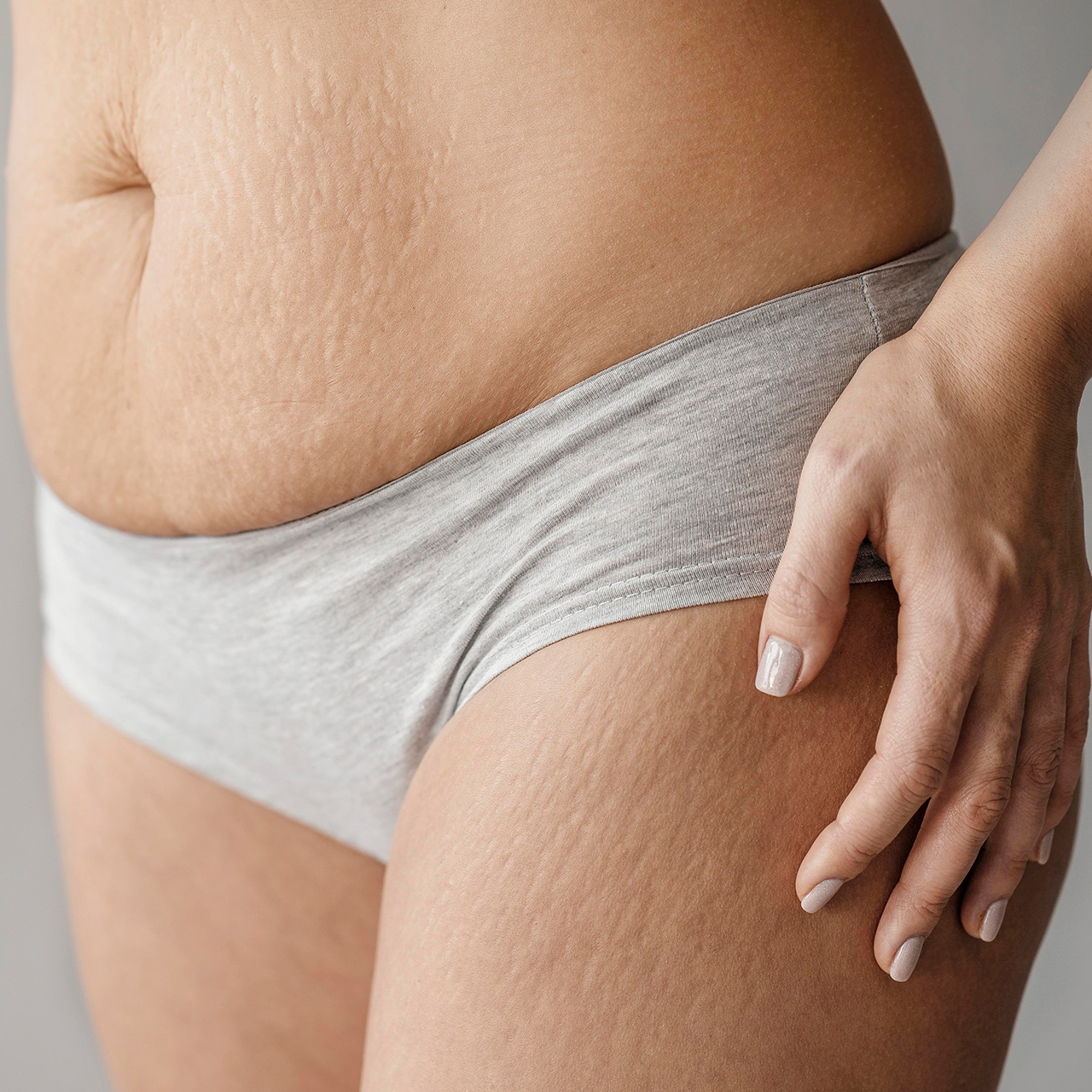Silhouette/Body
Achieve the Body of Your Dreams

Cellulite
It is estimated that approximately 80 to 90% of women worldwide have some form of cellulite, and 86% of women have skin laxity issues.
Cellulite (or superficial lipodystrophy) results from:
An abnormal local accumulation of adipose cells (fat) beneath the skin,
Coupled with water retention (local edema),
And an accumulation of toxins trapped in hardened collagen fibers (fibrosis).
This fatty deposit is located in the hypodermis, which is the deep layer of the skin. When the volume and number of adipocytes increase, the skin's surface appears dimpled or wavy (resembling orange peel).
CAUSES OF CELLULITE
Although the exact reasons for the development of cellulite in certain individuals are still not fully understood, contributing factors have been identified:
Hygiene and lifestyle factors (diet, lack of physical exercise, stress),
Hormonal factors (water retention, excessive estrogen production, insulin),
Poor blood and lymphatic circulation,
Genetics (ability to burn fat, total number of adipocytes, etc.).
At the skin level, the main causes are as follows:
Hypertrophied adipose pockets in the hypodermis exert outward pressure between the interlobular spaces.
Collagen fibers remain rigid and exert tension inward, opposing the outward pressure (resulting in dimpling).
Loss of skin elasticity reduces resistance to internal outward pressure.
Poor blood circulation.
Accumulation of metabolic waste in the interstitial spaces.
DIFFERENT TYPES OF CELLULITE
There are different types of cellulite, each with its specific characteristics. Here are the main types:
Aqueous Cellulite: Aqueous cellulite is not very visible, diffuse, and soft. It is often caused by blood and lymphatic circulation problems. Although it is not painful, it is often accompanied by swollen legs (water retention) and a feeling of heaviness in the legs.
Adipose Cellulite: Adipose cellulite is painless, localized, and soft. It is mainly caused by an unbalanced diet and lack of physical exercise. This type of cellulite is often associated with excess body fat.
Fibrous Cellulite (or Indurated Cellulite): Fibrous cellulite is a more advanced stage of cellulite. It is painful, has a hard texture, and may appear bluish-purple. Fibrous cellulite is usually established in the tissues for a long time, making its elimination more difficult.
It is important to note that each type of cellulite may require a specific treatment approach. Treatment options include cryolipolysis, focused ultrasound, radiofrequency, pressotherapy, massages, and topical treatments.
TREATMENTS IN AESTHETIC MEDICINE FOR CELLULITE
To treat cellulite, various options of aesthetic medical treatments can be considered to combat or reduce this condition deeply embedded in the dermis:
Cryolipolysis and focused ultrasound (HIFU) are commonly used techniques to treat adipose cellulite.
Radiofrequency is a recognized and effective medical treatment in the fight against cellulite.
Pressotherapy is often recommended to improve lymphatic and venous circulation and reduce the appearance of cellulite.
Shockwaves are a treatment option for fibrous cellulite.
Mesotherapy is sometimes used to improve local blood circulation and reduce fibrosis.
While aspiration or massage techniques may temporarily relieve water retention, they do not directly address the main cause of cellulite, which is the stiffening of collagen fibers between the adipose lobules in the hypodermis of women.
In many cases, it may be beneficial to combine several of these treatments to achieve optimal results. It is essential to consult a qualified professional in aesthetic medicine to assess your specific situation and determine the best treatment approach tailored to your needs. However, it is important to note that the effectiveness of treatments can vary from person to person, and each case of cellulite is unique.
HOW EMTONE® WORKS ON CELLULITE AND SKIN LAXITY
The revolutionary Emtone® system works by simultaneously deploying radiofrequency (thermal impact) and targeted pressure energy (mechanical impact). Within 60 to 90 seconds, the therapeutic temperature of 42 degrees is reached using the applicator. Throughout each session, heat regulation is constantly monitored to ensure patient comfort. The targeted pressure by radiofrequency ensures that the treated area receives even heat and powerful mechanical stimulation for optimal results.
Emtone® tackles the deep causes of cellulite by addressing the core of the problem rather than just improving the external appearance. This strategy ensures fast and long-lasting results.
Emtone® is the only device that targets all five triggering factors of cellulite and skin laxity. Simultaneously releasing two forms of energy has been shown to have a significantly greater influence on connective tissue than their sequential application. This makes it a powerful solution for cellulite and skin issues.
EMTONE TREATMENT SEQUENCE
During your first appointment, the doctor will work with you to design a personalized Emtone® treatment program.
The majority of patients follow a sequence of 6 sessions, usually scheduled once or twice a week. Each session is generally divided into two segments of 12 minutes each, except for abdominal treatment, which is done in a single 12-minute session.
The Emtone® treatment sequence is conducted by an experienced assistant nurse.








